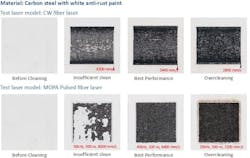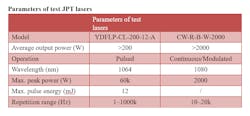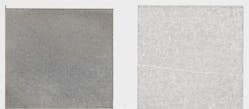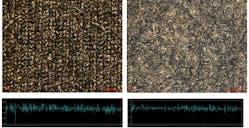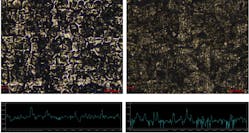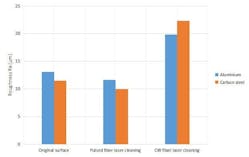LULU SONG, JIANFENG SHANGGUAN, CAIJIE LI, and DAISHU QIAN
Laser cleaning uses a focused laser beam to rapidly vaporize or strip the contaminants on a material’s surface. Compared with other traditional physical or chemical cleaning methods, laser cleaning is non-contact, with no consumables or pollution, high precision, and small residual damage. This process is an ideal choice for the new generation of industrial cleaning technology.
Furthermore, fiber lasers with high reliability, stability, and flexibility have become the best choice as a laser cleaning beam source. Two types of fiber lasers, continuous-wave (CW) fiber lasers and pulsed fiber lasers, occupy the market for macromaterial processing and precise material processing. For emerging laser cleaning applications, there are questions about whether the CW fiber laser or pulsed fiber laser should be used. Here, we compare the laser cleaning applications of CW fiber lasers and pulsed fiber lasers, and analyze their respective characteristics and applicable application scenarios. This article provides useful reference when choosing the corresponding laser cleaning technology.For pulsed fiber lasers, a laser with lower frequency is more likely to hurt the substrate during the cleaning process, and a laser with a narrow pulse width (around 100 ns) could clean the paint more easily. It’s essential to balance the heat between cleaning the paint and melting the substrate (heat effect). A pulsed fiber laser with a master oscillator power amplifier (MOPA) structure offers the advantage of precise heat control, which is a critical point during the cleaning process.
With a CW fiber laser, the slower the scanning speed is, the greater the damage to the substrate. However, when the speed is higher than the threshold, a faster speed will cause insufficient cleaning. Thus when using the CW fiber laser to perform laser cleaning, it’s critical to choose the right scanning speed.
The following details show the difference between CW fiber lasers and pulsed fiber lasers from three main aspects: cleaning performance, cleaning efficiency, and roughness after the cleaning process.Another advantage brought by the MOPA fiber laser is high cleaning efficiency. When cleaning the dust on the aluminum alloy, the cleaning efficiency of the MOPA pulsed fiber laser is 2.77 m2/h, which is 7.7X the cleaning efficiency by a CW fiber laser (0.36 m2/h). When cleaning the dust on the carbon steel, the cleaning efficiency of the MOPA pulsed fiber laser is 1.06 m2/h, which is 3.5X the cleaning efficiency of the CW fiber laser (0.3 m2/h).
In conclusion, dust could be removed by both the MOPA pulsed fiber laser and CW fiber laser. Using the same average output power, the cleaning efficiency of the MOPA pulsed fiber laser is quicker than the efficiency of the CW fiber laser. In the meantime, precise heat control between cleaning and melting produces good cleaning performance, without damaging the substrate.
However, the cost of a CW fiber laser is lower, which compensates for the disadvantage of the cleaning efficiency by increasing the average output power. However, it will cause a heat effect, which will hurt the substrate.
Thus, different cleaning applications will require different laser models. For precise cleaning such as mold cleaning, it is better to choose the MOPA pulsed fiber laser. For some large steel structures, pipes, etc., due to their large volume, fast heat dissipation, and low requirement for substrate damage, the CW fiber laser will be a good choice. JPT has a specialized application lab with highly trained engineers and various types of equipment used for different applications (marking, cutting, welding, etc.), which helps customers to evaluate the processing characteristics before choosing the appropriate laser.
Lulu Song, Jianfeng Shangguan, Caijie Li, and Daishu Qian are all with JPT Opto-electronics Co., Ltd., Shenzhen, China; en.jptoe.com.

